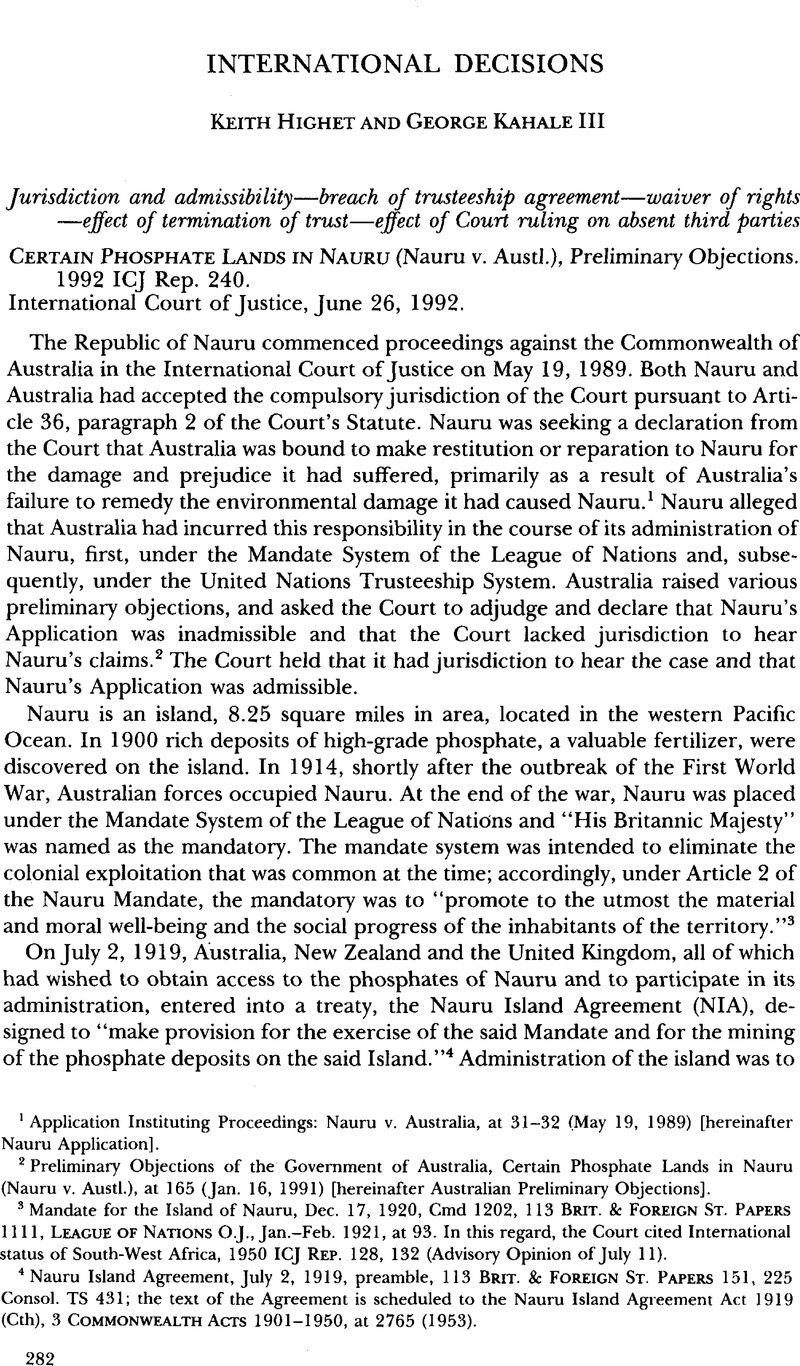Published online by Cambridge University Press: 27 February 2017

1 Application Instituting Proceedings: Nauru v. Australia, at 31–32 (May 19, 1989) [hereinafter Nauru Application].
2 Preliminary Objections of the Government of Australia, Certain Phosphate Lands in Nauru (Nauru v. Austl.), at 165 (Jan. 16, 1991) [hereinafter Australian Preliminary Objections].
3 Mandate for the Island of Nauru, Dec. 17, 1920, Cmd 1202, 113 Brit. & Foreign St. Papers 1111, League of Nations O.J., Jan.–Feb. 1921, at 93. In this regard, the Court cited International status of South-West Africa, 1950 ICJ Rep. 128, 132 (Advisory Opinion of July 11).
4 Nauru Island Agreement, July 2, 1919, preamble, 113 Brit. & Foreign St. Papers 151, 225 Consol. TS 431; the text of the Agreement is scheduled to the Nauru Island Agreement Act 1919 (Cth), 3 Commonwealth Acts 1901–1950, at 2765 (1953).
5 NIA, supra note 4, Art. 1.
6 Id., Art. 6.
7 Id., Art. 7.
8 These were the proportions in which the phosphates produced in each year were to be divided among the three governments. Id., Art. 14.
9 Id., Art. 13.
10 Trusteeship Agreement for the Territory of Nauru, Nov. 1, 1947, Art. 2, 10 UNTS 3.
11 Id., Art. 4.
12 UN Charter Art. 76(b).
13 The background to the case is extensively presented in C. G. Weeramantry, Nauru: Environmental Damage Under International Trusteeship (1992).
14 Nauru Application, supra note 1, at 26.
15 Id. at 30; see also 1992 ICJ Rep. 240, 243–45, para. 5.
16 1992 ICJ Rep. at 245, para. 8.
17 Id. at 249, para. 17.
18 Id. at 250, para. 19.
19 Case concerning the Northern Cameroons (Cameroon v. UK), Preliminary Objections, 1963 ICJ Rep. 15 (Dec. 2).
20 1992 ICJ Rep. at 251, para. 23.
21 Id. at 254, para. 35.
22 Australian Preliminary Objections, supra note 2, at 159, para. 393.
23 1992 ICJ Rep. at 254–55, para. 36.
24 Australian Preliminary Objections, supra note 2, at 162, para. 404.
25 See text at note 11 supra.
26 Because the ordinances enacted by the Administrator were subject only to the approval of the relevant authority of the Government that had appointed the Administrator, the Governor-General of Australia alone exerted control over the Administrator throughout the relevant period.
27 Case of the monetary gold removed from Rome in 1943 (Preliminary Question), 1954 ICJ Rep. 19, 22 (June 15).
28 Military and Paramilitary Activities in and against Nicaragua (Nicar. v. U.S.), Jurisdiction and Admissibility, 1984 ICJ Rep. 392, 431 (Nov. 26).
29 1954 ICJ Rep. at 32.
30 This aspect of the Judgment is the subject of an elaborate separate opinion by Judge Shahabuddeen and a dissenting opinion by Judge Schwebel. The other dissenting judges on this issue were the President, Sir Robert Jennings, Vice-President Oda and Judge Ago.
31 The separate opinion of Judge Shahabuddeen and the dissenting opinion of Judge Schwebel (on the effect of the absence of the United Kingdom and New Zealand) develop aspects of the Monetary Gold principle.